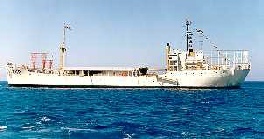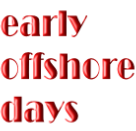© 2014-

Early Offshore Days (3)
Other offshore broadcasters
There are further examples of early offshore radio stations, which were either non-
Radio Morue (Radio Cod) accompanied French fishing fleets to the waters around Newfoundland in the late 1930s. The station, based on one of the trawlers, was operated by Rev. Yvon and broadcast religious messages and news items from home to fishermen on board other vessels in the fleet.
Estacion Pyrenees In 1941 Spanish Communists, who had been exiled by the right-
Radio Euzkad was another floating radio station established by a Spanish political group, this time separatists who claimed to be the Basque Government in exile. They used a trawler anchored in the French port of Bayonne to broadcast anti-
Voice of America the United States Government propaganda station used a number of ships as offshore bro adcasting bases, particularly during the 1940s and 1950s. In 1942 the USS Texas was anchored in the Mediterranean and equipped to broadcast Voice of America programmes as a counter to the many Nazi propaganda stations then on the air. These programmes, targeted at North Africa, were transmitted on 601kHz (498m) and commenced on 7th November 1942, coinciding with an Allied military advance in that area. However, some rapid Allied successes against the Nazi forces in North Africa meant that the station's mission became obsolete and transmissions were terminated after only a few weeks.
adcasting bases, particularly during the 1940s and 1950s. In 1942 the USS Texas was anchored in the Mediterranean and equipped to broadcast Voice of America programmes as a counter to the many Nazi propaganda stations then on the air. These programmes, targeted at North Africa, were transmitted on 601kHz (498m) and commenced on 7th November 1942, coinciding with an Allied military advance in that area. However, some rapid Allied successes against the Nazi forces in North Africa meant that the station's mission became obsolete and transmissions were terminated after only a few weeks.
Three years later, in 1945, the Voice of America again used a ship, this time the Phoenix, anchored in the China Sea to broadcast propaganda programmes to the Far East on both shortwave and medium wave frequencies.
The most significant use of an offshore based transmitter by the Voice of America came in the early 1950s and was to serve as a role model for early European offshore commercial broadcasters. A merchant ship, Doddridge was converted, at a cost of $3.5million, into a floating radio station and renamed firstly Coastal Messenger and later Courier. The station was fitted out by US Coastguards who installed three on-
Test broadcasts from this ship-
In August 1952, havin g successfully completed her test transmissions the Courier sailed to the Mediterranean and anchored off the Greek Island of Rhodes, commencing broadcasts as the Voice of America -
g successfully completed her test transmissions the Courier sailed to the Mediterranean and anchored off the Greek Island of Rhodes, commencing broadcasts as the Voice of America -
A full history of this station can be found in the Rest of the World Gallery on Floor 1
Commercial interest
While the practice of using ship-
It is extremely doubtful that the people behind Radio Mercur knew anything about RKXR or other early attempts to launch offshore radio stations. They had simply identified a legal loophole enabling them to operate from international waters and challenge the established state broadcasting system in Denmark. Despite numerous practical difficulties they succeeded and Radio Mercur itself went on to inspire the establishment of many similar stations throughout Europe and other parts of the world.
Also the successful operation of the ship-
Courier at anchor off Rhodes





Ground
Floor
Back to


State Monopolies and International Agreements









Back to Gallery index


Click images to enlarge
